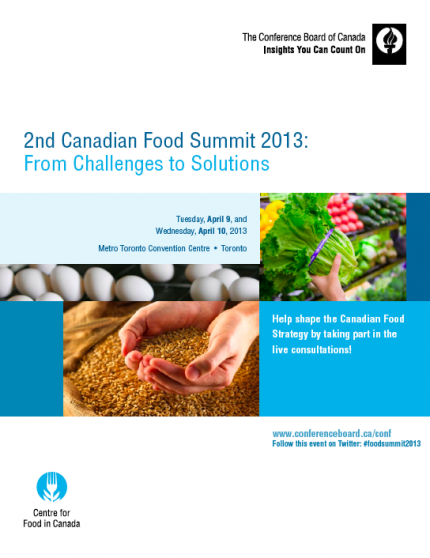Conference Board of Canada Food Summit
Posted: April 19, 2013
Categories: Food Strategies / GoodFoodBites / News from Sustain Ontario / Policy News
Last week’s Food Summit, put on by the Conference Board of Canada, re-ignited some exciting and tenacious discussion about the need to develop a national food strategy.
Held on the 9th and 10th of April at the Metro Toronto Convention Centre, the Conference Board presented its latest iteration of a Canadian Food Strategy, which is intended to provide “a comprehensive, evidence-based, action-oriented framework to guide and stimulate change in food and the food system.”
Whether from a livelihood, environmental, health and community wellbeing or social justice perspective, few concerned about the state of the food system would deny that Canada is long overdue for a national food strategy. Indeed, several organizations have already produced or are in the process of creating such documents. One of the most prominent examples is Food Secure Canada’s (FSC) Resetting the Table: A People’s Food Policy for Canada, which was completed in 2011.
Underlying FSC’s strategy is the understanding that the myriad of issues in the food system—the prevalence of hunger, malnutrition, diet-related diseases, the farmer income crisis, and the loss of food infrastructure—are linked and that addressing these issues depends on reconstituting the food system. As described by Food Secure Canada, “this means a shift from market-driven global supply chains to a more complex, regenerative, social and ecological web of relations.”
The food strategy put forward by the Conference Board takes a notably different approach. As an industry-led strategy, the Canadian Food Strategy is more heavily weighted toward the needs and interests of business. Thanks to the strong response by civil society following the Conference Board’s first Food Summit in February 2012, along with input provided through the online consultation process, the Conference Board has begun to include stronger language around environmental sustainability (e.g. reducing food waste and water usage) and the need to improve household food insecurity (e.g. instituting a national student nutrition program). Despite these gains, the Conference Board’s process and orientation remains unsettling.
In the past three years that the Conference Board has been developing its strategy, it has taken few opportunities to meaningfully engage with groups outside of business and industry associations. Groups such as civil society organizations representing small- and medium-scale farmers, educators, and health care professionals have had the opportunity to voice their concerns and ideas, but for the most part this has been limited to on-line surveys. Here the Conference Board has an opportunity to learn from the approach taken by Food Secure Canada to create A People’s Food Policy. Through one-on-one and small group discussions with 3,500 Canadians representing a diversity of interests and backgrounds, FSC was able to paint a picture of a food system that would be fair, ecological, and healthy for all.
The Ontario Food and Nutrition Strategy offers another model from which the Conference Board could learn from. Two years ago, the Ontario Collaborative Group on Healthy Eating and Physical Activity, in concert with Sustain Ontario, initiated a process of developing a coordinated, cross-ministerial approach to food policies and programming with the goal of ensuring that Ontario’s future is one of healthy people, a strong economy, resilient ecological systems, and more.
The Conference Board could also go a long way to increase the inclusiveness of its process by making its conference more financially accessible (tickets averaged $850 per person), prioritizing dialogue with non-traditional stakeholders, and creating more room for meaningful conversation across divides so as to create opportunities for moving forward together.
Perhaps because of its roots in industry and a tendency to underplay the depth, scale, and interconnectedness of food system issues championed by civil society, the Conference Board opted to feature strategies from the Netherlands, South Australia, and Scotland as models for Canada to follow. These so-called food strategies, with their emphasis on increasing production through biotechnology, innovation in the processing sector (e.g. through the chemical food industry), and growth through gaining access to new markets (requiring a sacrifice of supply management) are simply not the types of strategies that are able to tackle the challenges that we face.
The Conference Board’s process and orientation has resulted in a strategy that suffers several important omissions. For one, the strategy overlooks the importance and potential of small- and medium-scale enterprises, alternative supply chains, and innovative community solutions for improving wellbeing and fostering healthy public policy. Moreover, it forestalls any conversation about the ways in which the current trajectory of the food system in itself creates many of the very problems Sustain Ontario and its members and affiliates are trying to solve.
Only by engaging in meaningful dialogue with organizations like Food Secure Canada can the Conference Board begin to construct a strategy that is truly inclusive and representative of the needs of all Canadians. At the same time, it should not be overlooked that the Conference Board’s strategy has strengths that others can learn from, such as detailed actions for realizing objectives, as well as clear targets and metrics.
The Conference Board is right to acknowledge that Canada’s food system is in need of comprehensive reform. By bringing together industry voices, it has played a significant role in starting an important conversation within this sector. Real reform, however, will come from pushing the boundaries of what’s comfortable and familiar, by including voices that challenge one’s own position and set of assumptions. If the goal is to create something that is truly representative, and laying down a path on which to move substantially forward, then the Conference Board will need everyone at the table.

